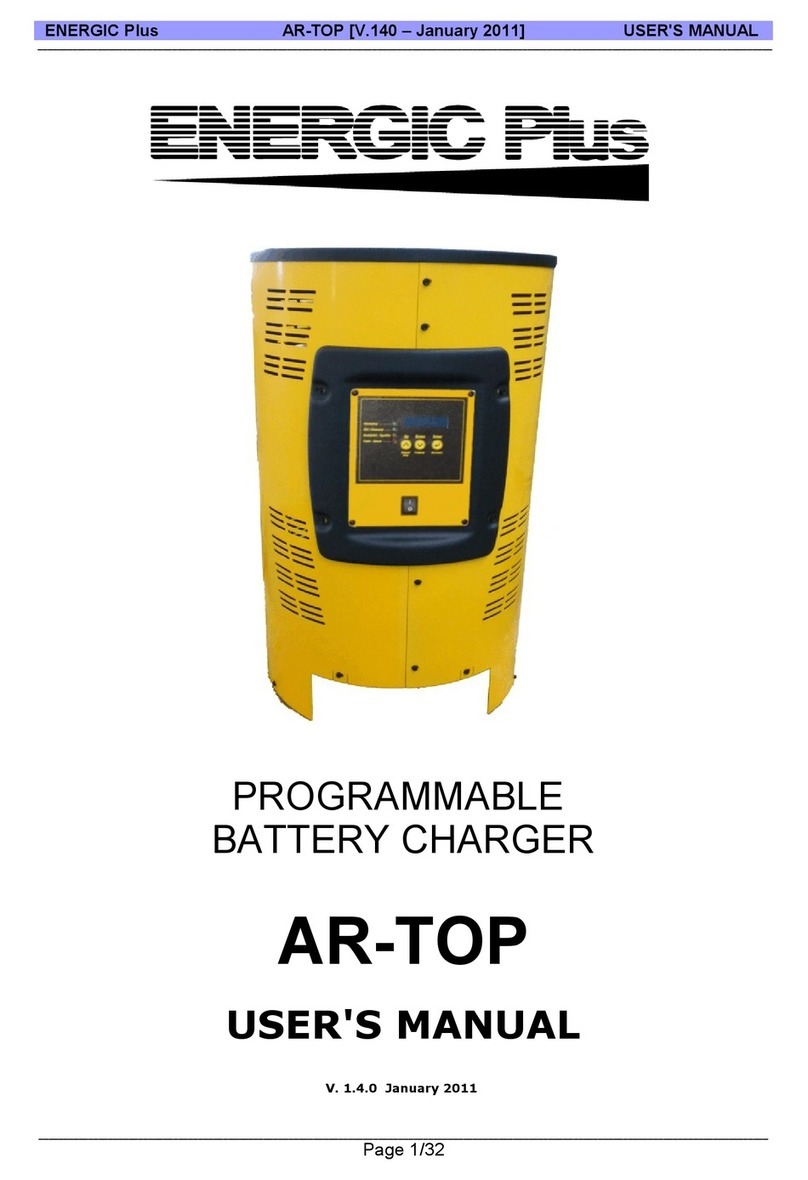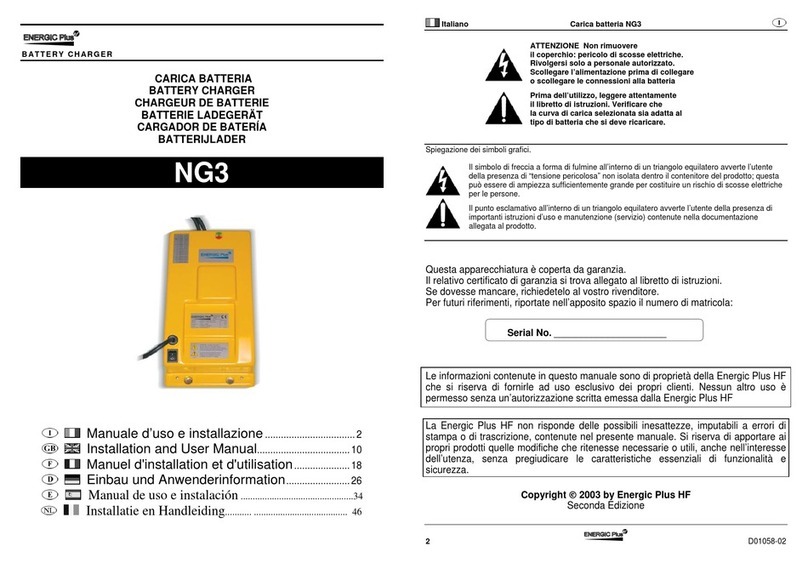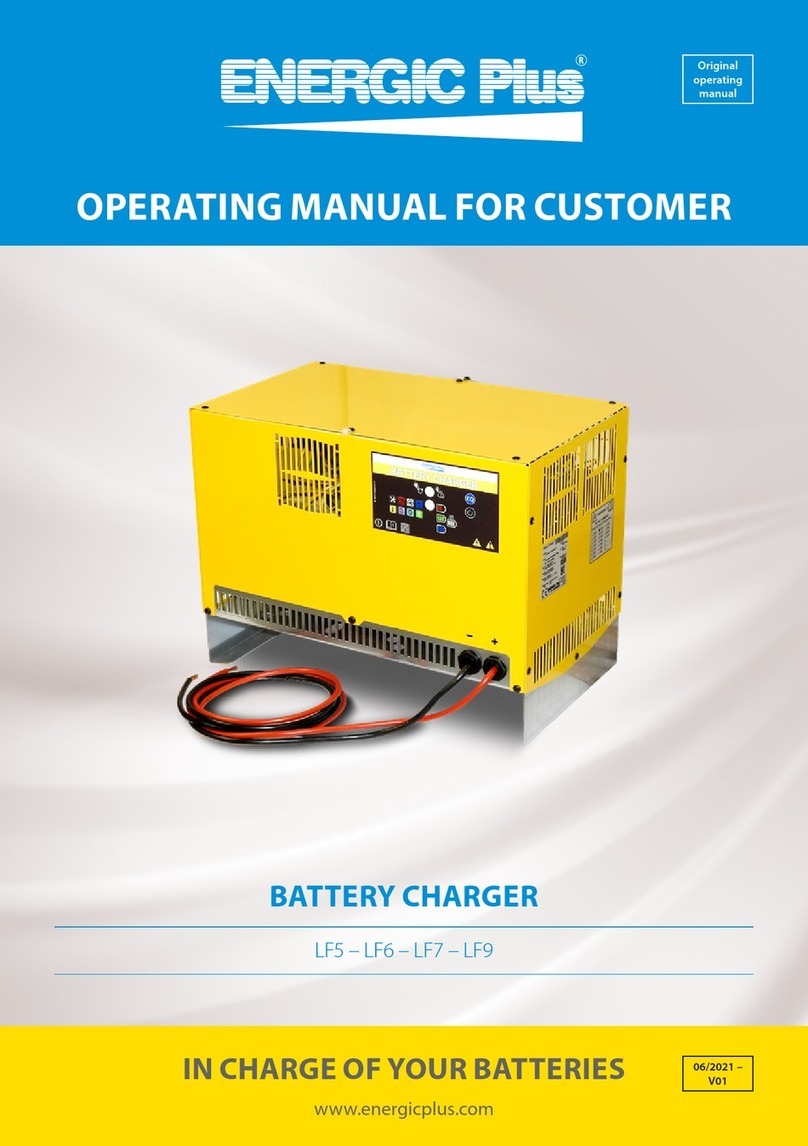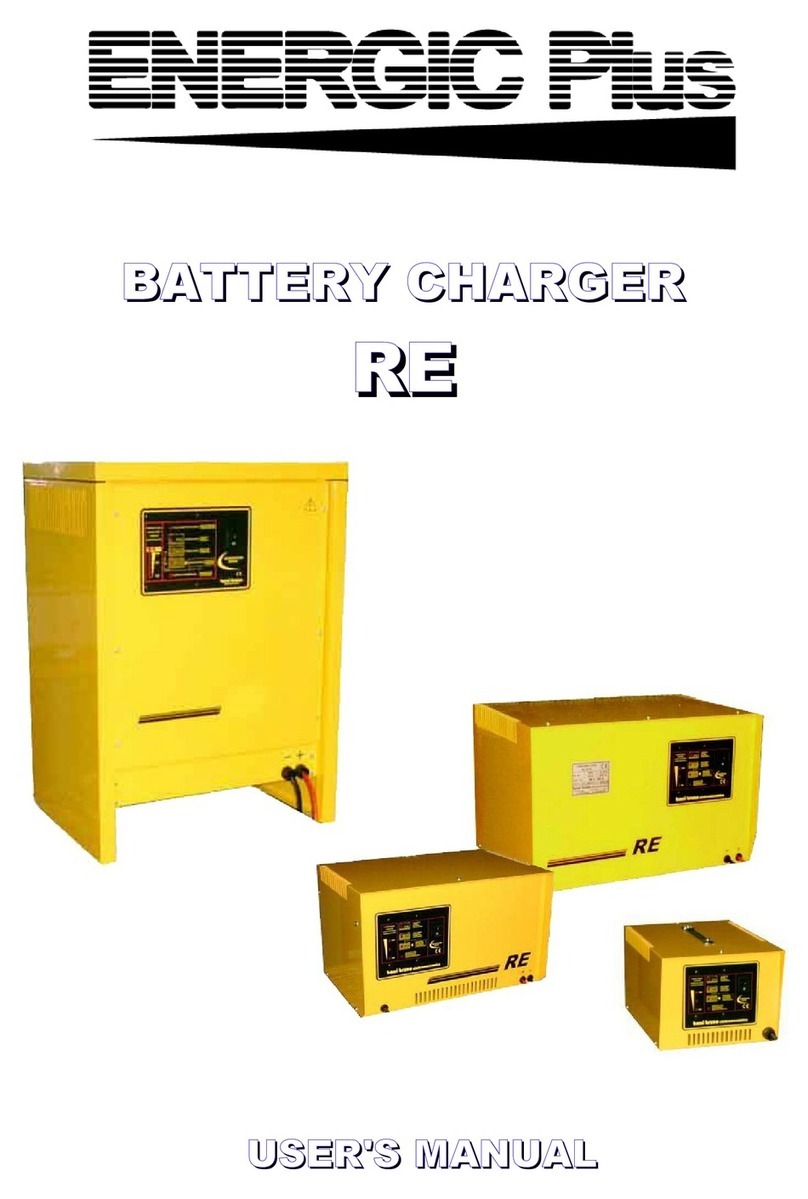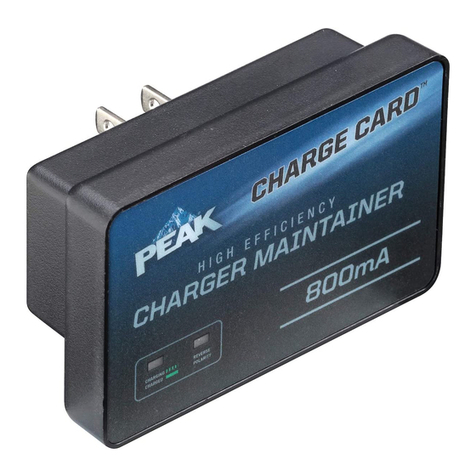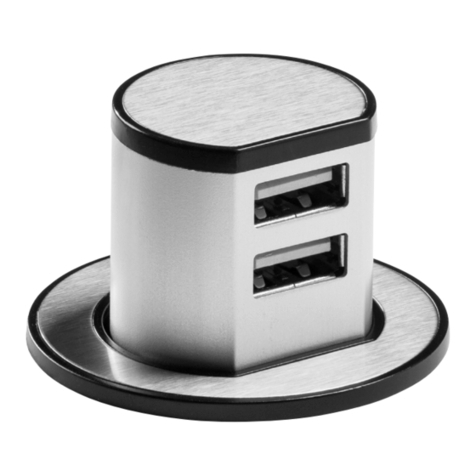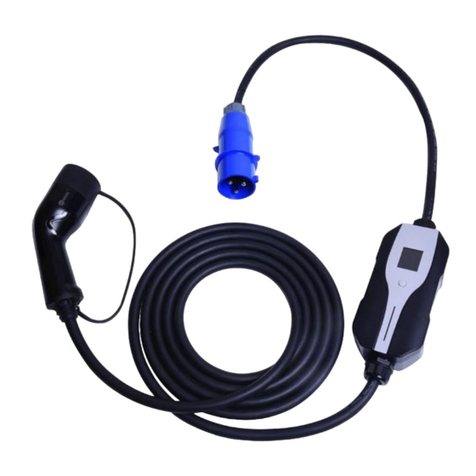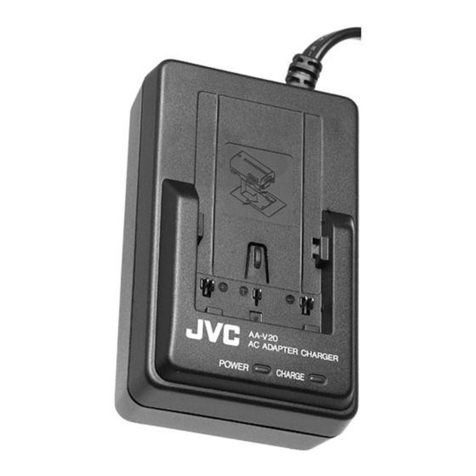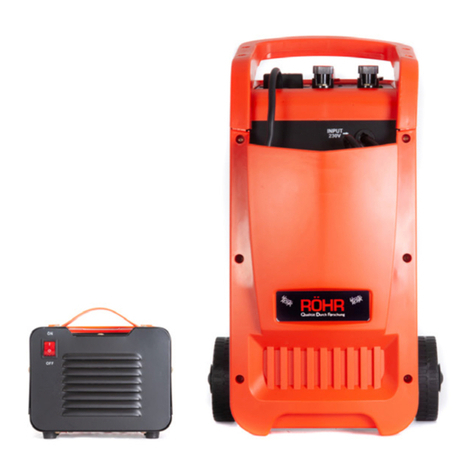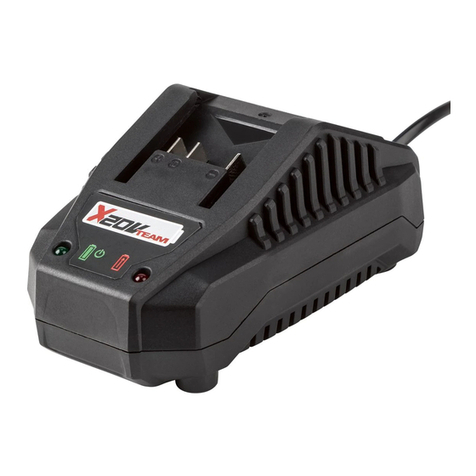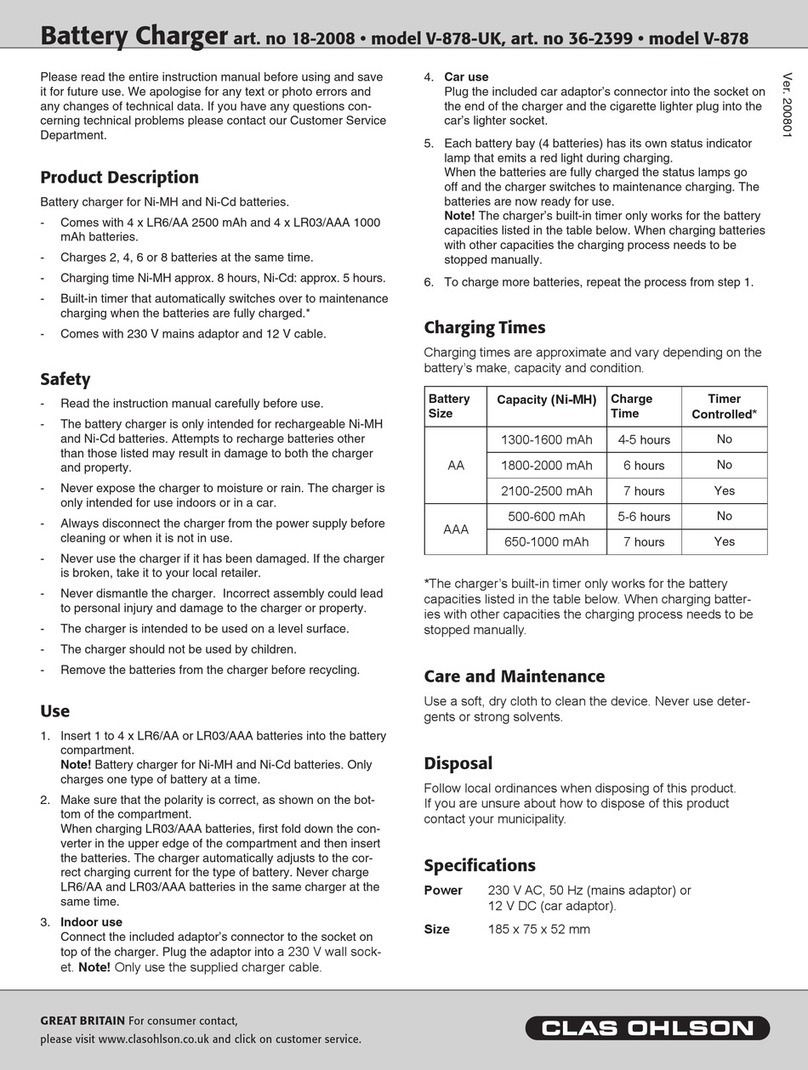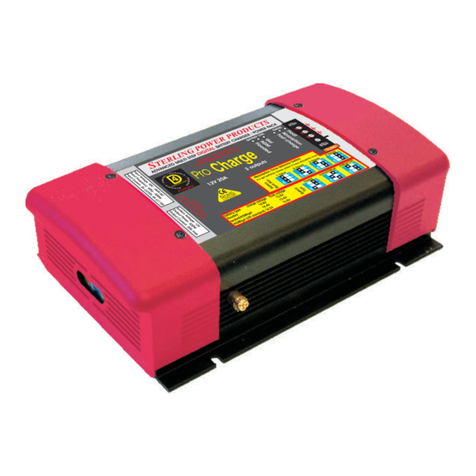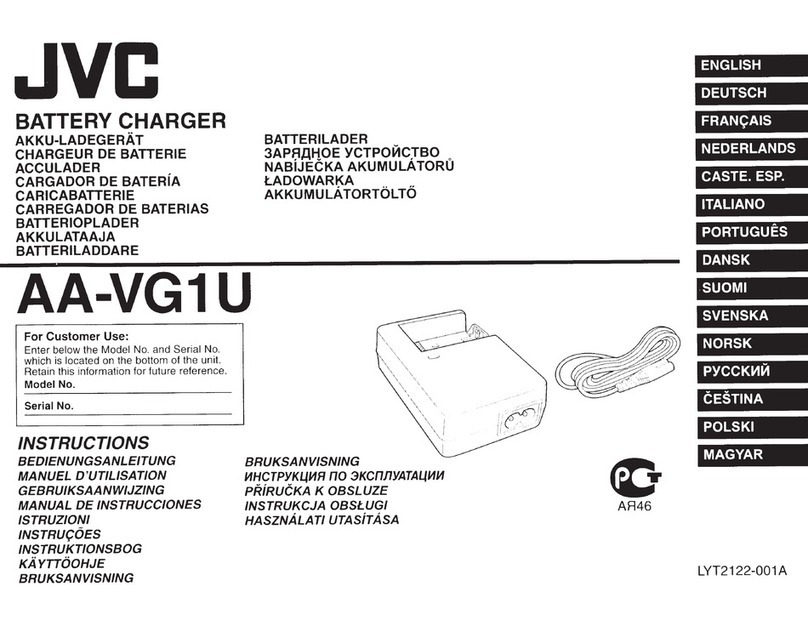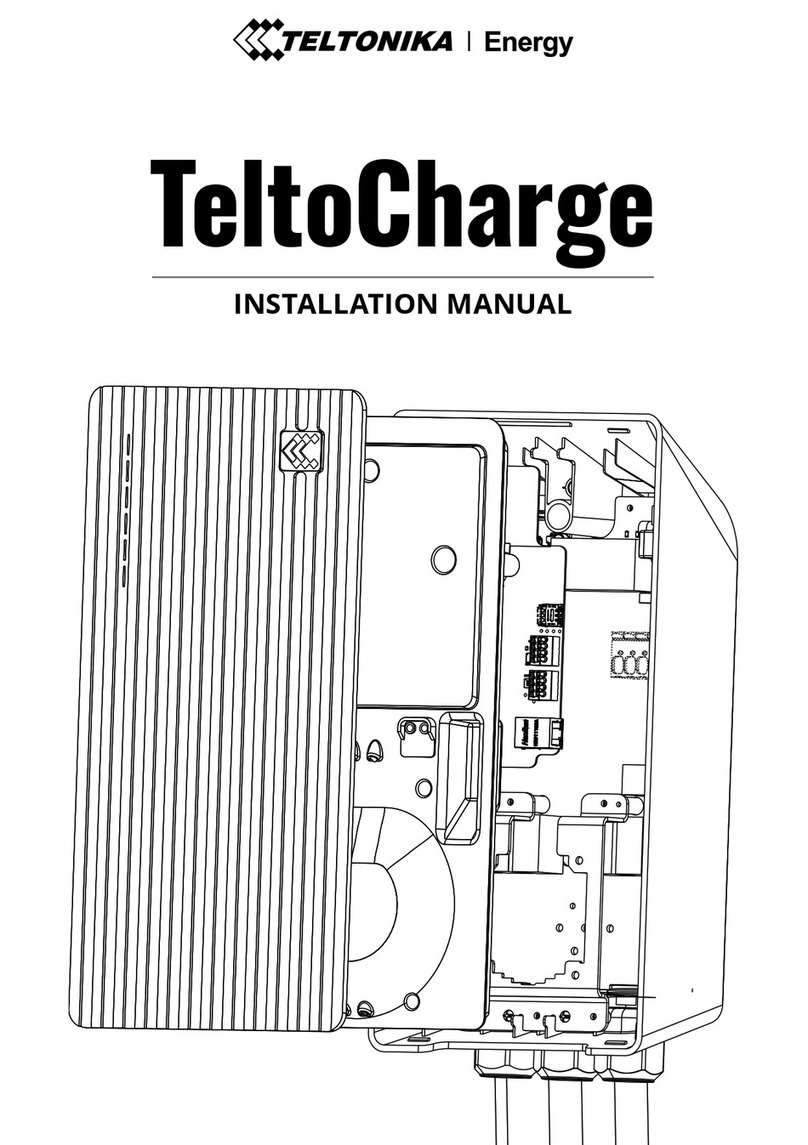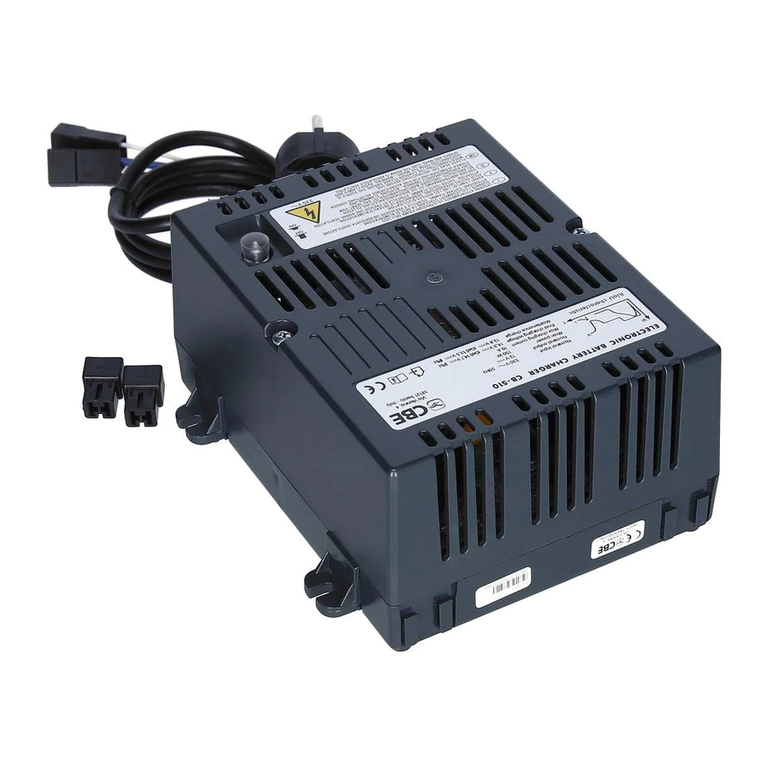Energic Plus NG1 User manual

IN CHARGE OF YOUR BATTERIES
www.energicplus.com
Original
operating
manual
07/2021– V01–
from s/n …
OPERATING MANUAL
HIGH-FREQUENCY BATTERY CHARGER
NG1 – NG3 – NG5 – NG7 – NG9

2/36
© 07-2021. Energic Plus is a trademark of TVH Parts Holding NV, Brabantstraat 15, B-8790 Waregem. All rights reserved. No part of this publication may be
reproduced or communicated in any form or by any means, electronic or mechanical, including copying, recording or use in an information storage or
retrieval system, without prior and explicit permission of TVH Parts Holding NV. Printing errors reserved. Photographs and illustrations are included for
reference purposes only.
Responsible editor: TVH Parts Holding NV, Brabantstraat 15, BE-8790Waregem
TVH is a supplier of after-market spare parts and accessories that are suitable for the maintenance and repair of OEM equipment.

3/36
www.tvh.com/highfrequencycharger_RV01
BG Bulgarian Можете да намерите това ръководство на Вашия език чрез линка, посочен по – долу.
CS Czech Tento návod najdete ve svém jazyce prostřednictvím odkazu níže.
DA Danish Du kan finde denne vejledning på dit sprog via nedenstående link.
DE German Sie finden diese Bedienungsanleitung in Ihrer Sprache unter folgendem Link.
EL Greek Μπορείτε να βρείτε αυτό το εγχειρίδιο στη γλώσσα σας μέσω του παρακάτω συνδέσμου.
EN English You can find this manual in your language via below link.
ES Spanish Encontrarás este manual en su propio idioma a través del siguiente enlace.
ET Estonian Oma emakeelse juhendi leiate allolevalt lingilt.
FI Finnish Löydät tämän manuaalin omalla kielelläsi alla olevan linkin takaa.
FR French Vous trouverez ce manuel dans votre langue via le lien ci-dessous.
GA Irish Tá an lámhleabhar seo ar fáil i do theanga tríd an nasc thíos.
HR Croatian Ovaj prirucnik mozete pronaci na svom jeziku putem donjeg linka.
HU Hungarian Ez a kézikönyv az Ön nyelvén az alábbi link alatt található.
IS Icelandic Hægt er að finna þessa handbók á þínu tungumáli á tenglinum hér að neðan.
IT Italian Cliccando sul link sottostante troverai il manuale nella tua lingua.
LT Lithuanian Šį vadovlėlį savo kalba rasite spustelėję žemiau esančią nuorodą.
LV Latvian Rokasgrāmatu latviešu valodā Jūs varat atrast izmantojot zemāk esošo saiti.
MT Maltese Tista’ssib dan il-manwal bil-lingwa tiegħek permezz tal-link ta’hawn taħt.
NL Dutch Je vindt deze handleiding in jouw taal via onderstaande link.
NO Norwegian Du finner denne håndboken på ditt språk via linken nedenfor.
PL Polish Niniejsza instrukcja obsługi dostępna jest wTwoim języku za pośrednictwem poniższego linku.
PT Portuguese Pode encontrar este manual no seu idioma através do link abaixo.
RO Romanian Puteți găsi acest manual în limba dvs. prin link-ul de mai jos.
SK Slovak Manuál vo vašom jazyku môžete nájst v priloženom vysvietenom riadku.
SL Slovenian Ta priročnik najdete v svojem jeziku preko spodnje povezave.
SV Swedish Du kan hitta denna manual på ditt språk via länken nedan.
TR Turkish Bu kılavuzu aşağıdaki bağlantıdan kendi dilinizde bulabilirsiniz.

4/36
Thank you for using our product. For your safety and to ensure a correct operation, we would like to
bring to your attention some aspects of this manual:
• This booklet supplies useful instructions for the correct operation and maintenance of the product.
It is therefore necessary to pay the utmost attention to all of the paragraphs that illustrate the most
simple and secure way to operate and use this product.
• This booklet must be considered an integral part of the machine and must be included with the
deed of sale.
• Neither this publication, nor part of it, can be reproduced without written authorisation on the part
of the manufacturer.
• All of the information reported herein is based on data available at the moment of printing;
the manufacturer reserves the right to carry out modifications to its own products at any moment,
without notice and without incurring in any sanction. It is therefore suggested to always check for
possible updates.
The person responsible for the use of the product must make sure that all of the safety rules in force in
the country of its use are applied, to guarantee that the equipment is used conform with the use for
which it is destined and to avoid any dangerous situation for the user.
The following warning signs are used in this manual to warn you for dangers and risks:
Informative, be careful.
Warning, can lead to injury and damage if instructions aren’t followed.
Danger, can lead to serious or fatal injury and serious damage if instructions aren’t
followed.
The following conventions are used in this manual:
For the charger without air pump:
1
6
5
4
2
3
1Top
2 Back
3Left
4 Bottom
5 Front
6 Right

5/36
TABLE OF CONTENTS
1. INTRODUCTION...............................................................................................6
2. DESCRIPTION..................................................................................................7
2.1. Technical data......................................................................................................................7
2.2. Main components of the product .......................................................................................10
2.3. Placement of the decals. . . . . . . . . . . . . . . . . . . . . . . . . . . . . . . . . . . . . . . . . . . . . . . . . . . . . . . . . . . . . . . . . . . . . . . . . . . . . . . . . . . . . . . . . . . . . . . . . . . . . . 10
2.4. Type plate..........................................................................................................................11
3. SAFETY INSTRUCTIONS.................................................................................. 12
3.1. Explanation of the safety decals ..........................................................................................12
3.2. General safety instructions..................................................................................................12
4. TRANSPORT AND STORAGE............................................................................ 14
5. ASSEMBLY AND INSTALLATION....................................................................... 15
5.1. Packing list.........................................................................................................................15
5.2. Safety instructions..............................................................................................................15
5.3. Required material for assembling........................................................................................16
5.4. Installation of the charger...................................................................................................16
6. OPERATION................................................................................................... 17
6.1. Safety instructions for operating the product.......................................................................17
6.2. Operating instructions. . . . . . . . . . . . . . . . . . . . . . . . . . . . . . . . . . . . . . . . . . . . . . . . . . . . . . . . . . . . . . . . . . . . . . . . . . . . . . . . . . . . . . . . . . . . . . . . . . . . . . . . 17
7. MAINTENANCE.............................................................................................. 22
7.1. Safety instructions for the repair of the product ...................................................................22
7.2. Maintenance schedule .......................................................................................................22
7.3. Maintenance instructions ...................................................................................................22
8. TROUBLESHOOTING ...................................................................................... 24
9. TEMPORARILY OUT OF ORDER ........................................................................ 27
10. FINAL DECOMMISSIONING AND DISPOSAL...................................................... 28
11. ANNEXES ...................................................................................................... 29
11.1. CE-certificate .....................................................................................................................29
11.2. Spare parts lists ..................................................................................................................31
11.3. Medical and first-aid treatment...........................................................................................32

6/36
1. INTRODUCTION
This manual gives information about the commencement of operation, use and maintenance of
your newly purchased high frequency charger. Also included in this manual are a number of safety
instructions to create a safe working environment.
The high-frequency battery charger is an electronic device for professional use only, designed to
charge different types of batteries, depending on the firmware installed. This depends in part on the
application and the programmed software and may also be used as a power supply.
The difference with a traditional charger is that the high-frequency charger has extra parts with which
the mains voltage is first converted to a much higher frequency.
This is followed by a‘traditional’transformation, but at this frequency the transformer is much
smaller. This makes the high frequency charger much more compact and lighter than its traditional
counterpart.
Please read the manual thoroughly and observe the safety procedures before putting the unit into
operation. The operator and all persons who come into contact with the equipment should read it
carefully and regularly and have access to it at all times.
Keep this manual near the equipment and in a safe place for future reference!
Contact your dealer for any further questions or concerns you may have.
We hope you will enjoy working with your high frequency charger.
If you wish to use this high frequency charger in extreme conditions such as extreme heat,
extreme cold, extreme drought, etc. Please contact your dealer to discuss whether this
product is suitable for the activities you wish to undertake with the high frequency charger.
The high frequency charger may be unsafe if adequate maintenance is neglected. Therefore,
adequate maintenance facilities, trained personnel and procedures should be provided.
Maintenance and inspection shall conform to the following practices:
1. A scheduled planned maintenance, lubrication and inspection system should be followed
(see maintenance instructions chapter 7).
2. Only qualified and authorised personnel shall be permitted to maintain, repair, adjust and
inspect the high frequency charger.
3. Modifications and additions which affect capacity and safe operation shall not be
performed by the customer or user without the manufacturer’s prior written approval.
Capacity, operation and maintenance plates or decals shall be changed accordingly.
4. If modifications are made without written approval of the manufacturer, warranty will no
longer apply.
Any person in charge of putting the machine into operation, the operation itself or the
maintenance of the machine is urged to carefully read and observe the following instructions.
Make sure that the operators of this product are familiar with the safety instructions and follow
all the procedures. Neglecting these instructions can risk injury or death.
We guarantee a long period of trouble free operation if the unit is operated and maintained
correctly.

7/36
2. DESCRIPTION
2.1. Technical data
Always check the type plate for the correct information.
Type NG1 NG3 NG5 NG7 NG9
Operating range of temperature From −20 to
50 °C
From −20 to
50 °C
From −20 to
50 °C
From −20 to
50 °C
From −20 to
50 °C
Maximum relative humidity 90% 90% 90% 90% 90%
Switching frequency (kHz) 50 ± 5% 50 ± 5% 20 ± 5% 20 ± 5% 20 ± 5%
Frequency (Hz) 50 ÷ 60 50 ÷ 60 50 ÷ 60 50 ÷ 60 50 ÷ 60
Supply voltage (Veff) 230 ± 10% 230 ± 10% 400 ± 15% 400 ± 15% 400 ± 15%
Absorbed maximum current (Aeff) 10 22 10 14 18
Inrush current (A) <2.7 <1.35 <2.35 <2.35 <2.35
Absorbed minimum power (W) <5 <5 <10 <10 <10
Absorbed maximum power (kW) 1.7 3 5 7 9
Enclosure class IP20 IP20 IP20 IP20 IP20
Weight (kg) 2.2 5.5 9 9 9
Applicable on Lead-acid –
AGM – gel –
lithium-ion
Lead-acid –
AGM – gel –
lithium-ion
Lead-acid –
AGM – gel –
lithium-ion
Lead-acid –
AGM – gel –
lithium-ion
Lead-acid –
AGM – gel –
lithium-ion
NG1 without air pump
NG1 with air pump
160
8
4
249
295
1
95
216
249
540

8/36
NG3 without air pump
NG3 without air pump
NG5 without air pump
NG5 with air pump
95
1
00
220
7
430
368
220
2
10
445
540
550
470
270
104
1
63
657
565
268
210
2
71

9/36
NG7 without air pump
NG7 with air pump
NG9 without air pump
NG9 with air pump
550
470
270
104
1
63
657
565
268
210
2
71
550
470
270
104
1
63
657
565
268
210
2
71

10/36
2.2. Main components of the product
With air pump
1
2
3
4
6
5
8
9
7
6
10
N° Component
1Sticker that indicates battery
percentage
2 Typeplate
3Decal with safety warnings
4 Brand
5Drilling hole
6Output cable
7Indication table with the indicated
amperes and charging time
8 Ventilation
9Air pump
10 Plug
Without air pump
1
2
3
4
5
6
7
8
10
7
1
6
9
8
N° Component
1Input cable
2Screen with push buttons
3Type plate
4Decal with safety warnings
5 Brand
6On and off switch
7Drilling holes
8Output cable
9Indication table with the indicated
amperes and charging time
10 Ventilation
2.3. Placement of the decals
The safety and warning labels should be placed as indicated in the pictures below. See chapter 3 for
the explanation of the safety warnings. If the decals are damaged or missing, replace them.
4
2
5
3
1

11/36
N° Decal Explanation Reference
1Indication table with the indicated amperes and
charging time
166TA4354
2Type plate 166TA5462
3Brand 166TA4355
4Indicates battery percentage 166TA4356
5Safety warnings 163TA4206
2.4. Type plate
1
2
34
56
9
8
7
N° Explanation
1 Brand
2 Model
3 Input
4 Output
5Unique code per product.
6Serial number
7Additional data of the charger
8CE marking
9 Address

12/36
3. SAFETY INSTRUCTIONS
3.1. Explanation of the safety decals
If the decals are damaged or missing, please replace them.
Decal Explanation Reference
4
5
1
2
3
1. This is an electrical device
2. Be careful when working with electrical
equipment
3. This device emits heat
4. Read the manual before using the
product
5. Keep the product away from rain or
damp places
163TA4206
3.2. General safety instructions
• TVH Parts Holding NV cannot envisage each possible circumstance that may result
in danger. Therefore the warnings given in this publication and which appear on the
equipment are not exhaustive.
In the event that equipment, procedures, work methods or working techniques are used
that are not specifically advised by theTVH Parts Holding NV company, it is necessary to
make sure that there is no danger to the operator or other people.
• Electrical equipment must be installed and maintained in accordance with all the applicable
national and local codes. A power disconnect switch must be located near the equipment.
Check the data label for voltage and phase requirements
• Always keep sparks, flames, burning cigarettes and other sources of ignition away from the
battery charging area.

13/36
• The person responsible for the use of the product must make sure that all of the safety rules
in force in the country of its use are applied, to guarantee that the equipment is used in
conformity with the use for which it is destined and to avoid any dangerous situation for the
user.
• Do not operate the product unless you are of age.
• Read this manual carefully. Make sure that the manual is available at all times and store it in a
dry, dark place near the unit.
• Do not touch the battery terminals while the equipment is running.
• To prevent damage to the power cord, do not lay anything on the power cord or place it
where it will be walked on. If the cord is damaged, consult qualified personnel to replace it
immediately.
• The cables must never be tensioned. Make sure there is always a little slack.
• Do not use the high frequency charger if the power cord is damaged, or if the high
frequency charger suffered a shock, was dropped, or was damaged in any other way.
• If you are using an extension cord or power strip, make sure that the total amperage
required for all equipment on the extension cord is less than the rated value of the
extension cord.
• Do not use the high frequency charger on automotive starter batteries with thermal
engines.
• Keep the inner parts clean and dry. Dirt and/or moisture can cause insulation failure.
This failure can result in high voltage at the charging output.
• The battery produces very high currents when short-circuited and will seriously burn the
skin if it comes into contact with a metal conductor carrying this current.
• Under no circumstances should jewellery or conductive material come into contact with
the battery terminals or the cell connectors on top of the battery.
• Battery acid is very corrosive.The operator or persons using the discharger and/or battery
must always wear protective gloves and eye protection.
• We strongly recommend to wear rubber aprons and face protection as well.. If you do come
into contact with battery acid, follow the instructions in chapter 11.5.
• The ventilation system in the room where the batteries are stored should be designed
to provide an adequate amount of fresh air for the number of batteries being charged or
discharged.
• Do not lay tools or anything metallic on top of any battery.
• Be sure the high-frequency charger is OFF before connecting or disconnecting the battery.
The digital display must be completely OFF.
• Do not open the cabinet. Only qualified personnel can open it.

14/36
4. TRANSPORT AND STORAGE
Always wear safety shoes and gloves when working with the high frequency charger or
battery.
1. Transport
You can find the weight of the high frequency charger in chapter 2.1:Technical data.
Determine if it is too heavy for you to carry or not.
If you decide that the high frequency charger is too heavy to carry, you can transport it on a cart with
wheels. If you transport it on a cart, lay the high frequency charger flat with the display facing upwards.
Make sure that the high frequency charger is fastened with a strap.
Don’t tension the strap in such a way that the LED screen and the digital part on the front of
the high frequency charger can be damaged.
2. Storage
• Make sure that the high frequency charger is located on a flat surface with the display facing
upwards.
• Make sure that there is no direct sunlight on the high frequency charger.
• Do not cover the high frequency charger so that it can cool down sufficiently.
• Do not place the high frequency charger in a humid area or a place where splashes of any kind of
liquid can fall on it. The relative humidity must be less than 75%.
• The high frequency charger should be stored in a space between –20 °C and 60 °C. Anything below
or above this temperature will damage the high frequency charger.
• Keep the high frequency charger away from areas where sparks are generated.
• Provide good ventilation to prevent the accumulation of oxyhydrogen.
• Place protection around the high frequency charger so that no one can drive into or collide with it.
• Place the high frequency charger on an elevated platform of at least 50 cm (19 inch) from the floor.
This will prevent fire caused by dust.
• Place a fire extinguisher close by.
• Install smoke detectors nearby.
• Do not place any objects on top of the high frequency charger.

15/36
5. ASSEMBLY AND INSTALLATION
5.1. Packing list
Description Amount Reference
High frequency charger 1Check your type
plate for the
correct reference
Input cable 1 166TA3457
Output cable 1 166TA3458
Manual 1 166TA8759
5.2. Safety instructions
• The high frequency charger must be installed by qualified personnel only.
• Use correct mating receptacles. Check the earthing for electrical continuity before using
the equipment. The earthing conductor must be a size equal to or larger than the size
recommended by code or this manual.
• Always wear safety shoes and gloves when working with the high frequency charger
or battery. If you do come into contact with battery acid, follow the instructions in
chapter 11.5.
• Check that the unit’s operating voltage is identical to your local power supply.
• Check that the unit’s maximum input power is available from your power supply.
• To prevent fire or shock hazard, do not expose the unit to rain or moisture.
• The high frequency charger is not for outdoor use.
• Allow adequate air circulation.
• Do not place the unit near materials that may block the ventilation slots.
• Do not install the unit near heat sources such as radiators or air ducts.
• Do not install the unit in a place where there is direct sunlight, excessive dust, mechanical
vibration or shock.
• Make sure that the high frequency charger is installed as instructed in this manual and in
accordance with any applicable national or local norm.
• Attach the high frequency charger to a stable surface. Make sure you attach the charger
correctly by mounting the correct holes in the mounting flanges.
• In case of installation on a vehicle, it is recommended to use anti-vibration brackets.
• The high frequency charger should preferably be installed in a vertical position with the fan
facing down. A horizontal installation is allowed.
• For safety and electromagnetic compatibility, the high frequency charger has a 3-way plug
as a safety feature and only fits into a grounded socket. If you are unable to insert the plug
into the socket, you may have an older, ungrounded socket. Do not continue to use the unit
and contact an electrician to have the outlet replaced. Do not use an adapter to bypass the
grounding.
• To avoid damaging the power cord, do not put anything on it, and don’t place it where it will
be walked on. If the cord becomes damaged or frayed, refer to qualified personnel to have it
replaced immediately.
• Do not drill additional holes in the high frequency charger or attach the high frequency
charger to the wall or to your vehicle by using adhesives of any kind.

16/36
5.3. Required material for assembling
The following supplies are a suggestion and not an instructional obligation.
• levelling scale
• pencil or marker
• 4 plugs (6 mm)
• drilling machine
• drill (6 mm)
• 4 screws (5 mm)
5.4. Installation of the charger
When mounting the high frequency charger, it is important
that you attach the high frequency charger upright to the
wall or to the vehicle.This means that the ventilation should
be at the bottom of the unit.
Top
Bottom
Ventilation
Each high frequency charger has drill holes to attach it to
the wall or to your vehicle.
Only use these drill holes to attach the high frequency
charger.
The assembly below is a suggestion and not an
instructional obligation.
1. Place the high frequency charger in the desired
location. Make sure it is level.
2. Mark the drill holes by using a pencil or marker.
3. Take a drill that has the same diameter as your plug.
4. Drill holes in the previously indicated places.
5. Place the plugs in the drilled holes.
6. Put the high frequency charger against the wall.
Make sure that the holes in the high frequency charger
match the holes in the wall.
7. Drill the high frequency charger to the wall.
Drilling holes
Drilling holes

17/36
6. OPERATION
6.1. Safety instructions for operating the product
• A damaged or malfunctioning machine must never be used. If damage or malfunctions are
discovered during pre-operation inspection or function tests, the machine must be tagged
and removed from service.
• For safety and electromagnetic compatibility, the high frequency charger has a 3-way plug
as a safety feature and only fits into a grounded socket. If you are unable to insert the plug
into the socket, you may have an older, ungrounded socket. Do not continue to use the unit
and contact an electrician to have the outlet replaced. Do not use an adapter to bypass the
grounding.
• A maximum distance of 3 meters between the high frequency charger and the battery is
recommended.
• Only people who work with the battery and the high frequency charger may be in the
vicinity of the devices. Other people must keep their distance.
• If you want to charge lead-acid batteries, be warned that an explosive gas is released during
charging. Avoid flames and sparks. Place the battery in an open, well-ventilated area.
• Battery acid is very corrosive. Always wear the correct eye and body protection when
you are near batteries. Always wear safety shoes and gloves when working with the high
frequency charger or battery. If you do come into contact with battery acid, follow the
instructions in chapter 11.3.
• Check that the available power supply voltage matches the voltage indicated on the
equipment’s type plate. If in doubt, consult your dealer.
• The battery produces very high currents when short-circuited and any metal conductor
that is carrying this current will burn the skin severely if they come into contact.
• Under no circumstances should jewellery or conductive material come into contact with
the battery terminals or the cell connectors on top of the battery.
• Do not charge batteries on board of thermal engines.
• Do not charge non-rechargeable batteries.
• Check that the selected charging curve is suitable for the type of battery to be recharged.
Take a good look at the rating plate of both the high frequency charger and the battery.
If in doubt, contact your dealer.
• Energic Plus is under no circumstances responsible if the charging curve selected was
incorrect and caused irreversible damage to the battery or the high frequency charger.
• Don’t recharge non-rechargeable batteries.
• If you are using an extension cord or power strip, make sure that the total of the amperes
required by all equipment on the extension, is less than the extension’s rating.
• To prevent fire or shock hazard, do not expose the unit to rain or moisture.
• The high frequency charger is not for outdoor use.
6.2. Operating instructions
Please see chapter 7 for the daily maintenance schedule.
If any of the following occurs while using the high frequency charger, stop using it
immediately by unplugging the power cord.
• Smoke and/or fire
• Burnt smell
• Inflation of the housing of the high frequency charger or battery

18/36
For N1–N3
1. Visualisation front high frequency charger
1. LED screen
2. Small LEDs indicating the value
3. LED light showing that the charger is charging
4. Small LEDs indicating the value
5. LED light showing that the charger has stopped
6. Push button to make selections
MODE
END CHARGE
ON CHARGE
Ah
A
t
V
1
2
3
4
5
6
As soon as you start the charger, the digital LED screen will
show the following parameters:
• The battery voltage (two-color upper LED)
• Current supplied by the charger (two-color red bottom
LED)
• Time
• Ah that the charger delivers (two-colour green bottom
LED)
MODE
A
h
A
t
V
In CAN bus mode only, pressing the MODE button once will fix the configuration of the parameters
and retain the last value displayed.
Pressing the MODE button again, allows you to change the parameter sequence.
During CG mode, pressing the MODE button will pause the charge or desulphation. Pressing the
button again will restart the high frequency charger from the last point where it stopped.
If you removed the battery, the high frequency charger will reset and will need to be configurated
again
2. How to use the high frequency charger?
Depending on how long you press the MODE button, you can perform various actions:
A. If you press the MODE button for more than 1 second, it means ENTER
B. If you press the MODE button for less than 1 second, it means ROLL.
1. Turn on the high frequency charger while pressing the MODE button.
2. ROLL: Select the CAN Node number.
3. Press the MODE button for more than 1 second so that the high frequency charger enters.
Now you can make a battery selection.
– Select BA1 for lead-acid batteries
– Select BA2 for gel electrolyte batteries.
4. Press ENTER: Confirm your battery type. Now you can make a curve selection.
5. ROLL: Make a curve selection.
The high frequency charger offers a total of five different charging curves. The available selections
are listed below:
– CU1: IUIa curve plus equalisation and maintenance
– CU2: IU1U2ob curve
– CU3: feed curve

19/36
– CU4: user programmable curve
– CU5: desulphurisation curve
6. Press ENTER: Confirmation of your charge curve. Now you can choose a capacity selection.
7. ROLL: make a capacity selection.
The starting point for capacity selection is the nominal value, but you can choose a value between
50% and 140% of the nominal value in 10% increments.
8. Press ENTER: Confirm the capacity confirmation. Now you can make a selection of the charging
time.
9. ROLL: Selection of the charging time.
From a suggested charging time (according to the capacity selected in the previous step),
this time, expressed in hours, can only be increased to a maximum of 20 hours.
10. Press ENTER: confirmation of the charging time.
In the CB firmware, the selection of the seasonal thermal compensation starts
11. ROLL: Seasonal compensation selection
The high frequency charger offers a total of three different seasonal thermal compensations,
which add or subtract a fixed amount to the output voltage during charging phases 1 and 2.
Please note that the seasonal thermal compensation only takes place if the thermal
compensation via the external probe is not switched on.
The available selections are listed below:
• Std: Standard compensation; no additional compensations are calculated. This means
that if the thermal compensation is enabled via the external probe, the high frequency
charger will perform the usual correction algorithm (e.g. 5 mV/(cell °K)), otherwise no
correction will be performed at all.
• Hot: hot season compensation; −40 mV/(cell °K) correction
• CoL: cold season compensation; +100 mV/cell correction
12. Press ENTER: Confirmation of seasonal thermal compensation.
The high frequency charger goes into standby mode until the output cables are connected to the
battery terminals.
If the connections have already been made before the configuration has started, the charging
starts immediately.
3. Load delay selection and use
To enter a delay between the connection of your battery and the actual charge:
1. Press and hold the MODE button for a long time during the standby state.Your battery must be
disconnected, and the display will show three dots with the message“dLY”.
2. ROLL: selection of load delay hours expressed in hours and minutes (e.g.“1.3h”indicates a delay of
one hour and thirty minutes).
3. ENTER: confirmation of the load delay.
Each time a battery is connected, the high frequency charger will display a flashing message
indicating the hours and tens of minutes until charging begins.
It is also possible to skip the delay and start charging immediately by pressing and holding the MODE
button for a while during the delay.
If the battery is disconnected during the delay, the high frequency charger will return to standby
status.

20/36
4. Compensation setting of the voltage drop on the output cables.
During charging, you can programme the voltage drop of the cables by pressing and holding the
MODE button. Perform the following steps while the high frequency charger is at maximum current.
1. Measure the voltage drop at the ends of the output bars of the battery charger (close to the cover).
2. Measure the voltage at the battery terminals.
3. Calculate the difference between the two values to compensate for the voltage drop.
4. Briefly press the MODE button until the voltage value is closest to the desired value: it is possible to
adjust the parameters between 0.0 V and 1.5 V in 0.1V increments.
5. Press and hold the MODE button (ENTER) to confirm.
5. Lights per phase
The charging status and the current charging phase of the high frequency charger are indicated via
the LED lights on the front of the high frequency charger.
Below, you can find a table of which lights are on per phase.
Below, you can find a table of which lights are on per phase.
Phase Red LED Green LED
Phase 1 On Off
Phase 2 On with short flashing Off
Phase 3 On On with short flashing
Phase 4 On with short flashing On with short flashing
Phase 5 & 6 Off On with short flashing
End phase Off On
When using the remote display by means of a two-colour LED (AUX F – Pin 1 and 2), the following
signals are valid:
Phase Red LED Green LED Yellow LED
Phase 1 On Off Off
Phase 2 On with short flashing Off Off
Phase 3 Off Off On
Phases 4–5–6 Off On Off
End phase Off On Off
S/S or alarm Off Off Off
6. Additional feature with air pump
Standard version
The air pump technology generates a remixing of the acid in the battery by means of a pump that
pumps air into the battery.
The high frequency charger controls the air pump via an auxiliary contact (usually AUX1).
The air injection cycle will be maintained throughout the charging period according to the
requirements of the battery specifications.
This manual suits for next models
4
Table of contents
Other Energic Plus Batteries Charger manuals
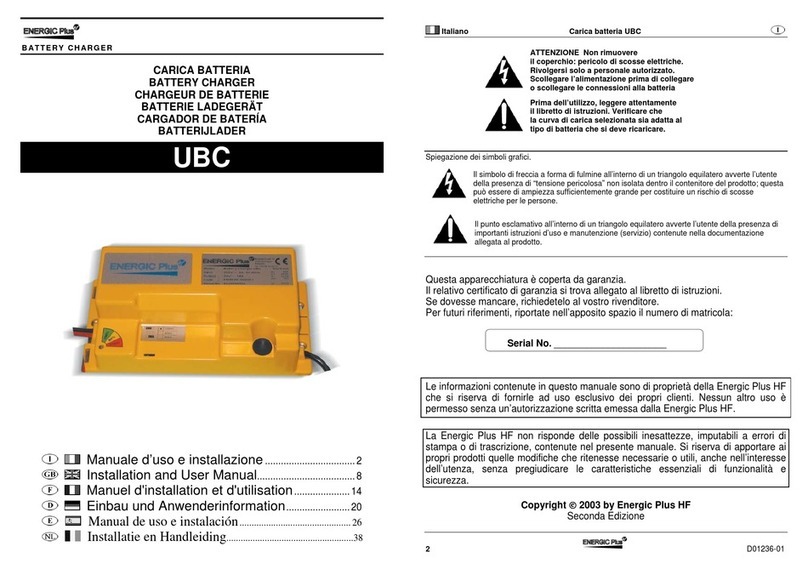
Energic Plus
Energic Plus UBC Manual
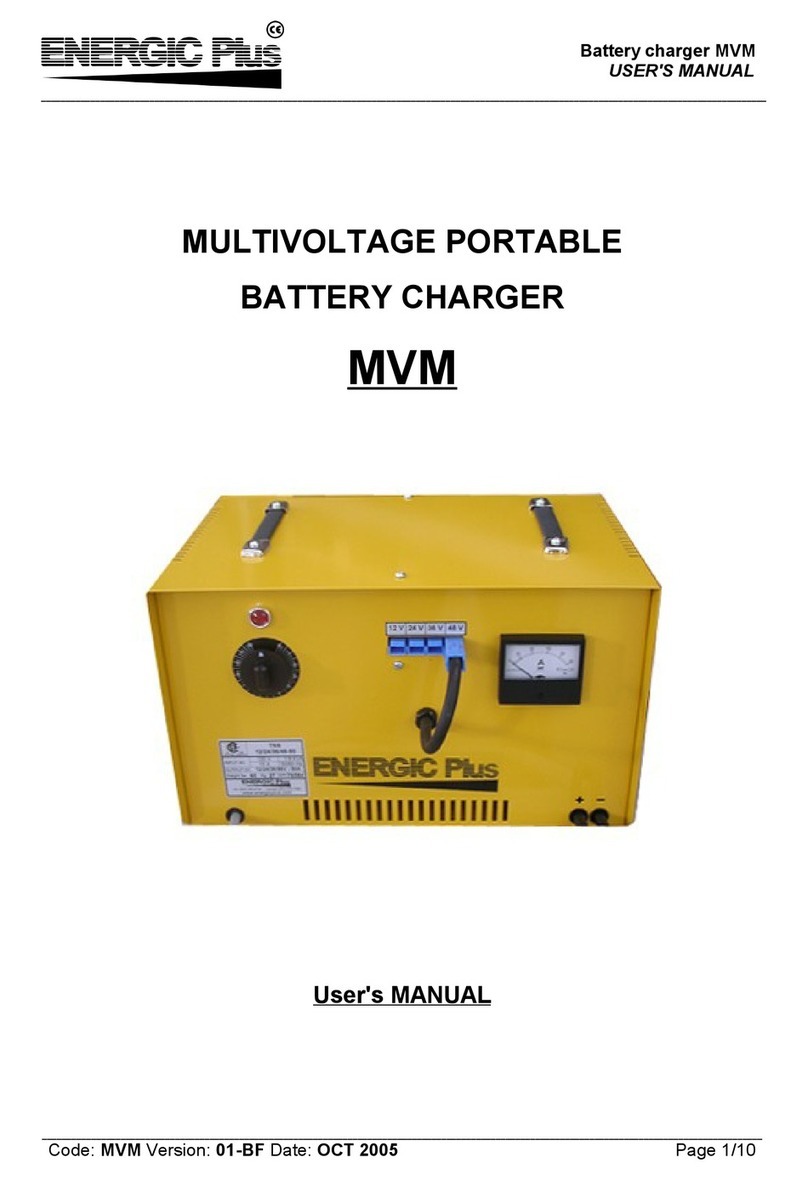
Energic Plus
Energic Plus MVM User manual
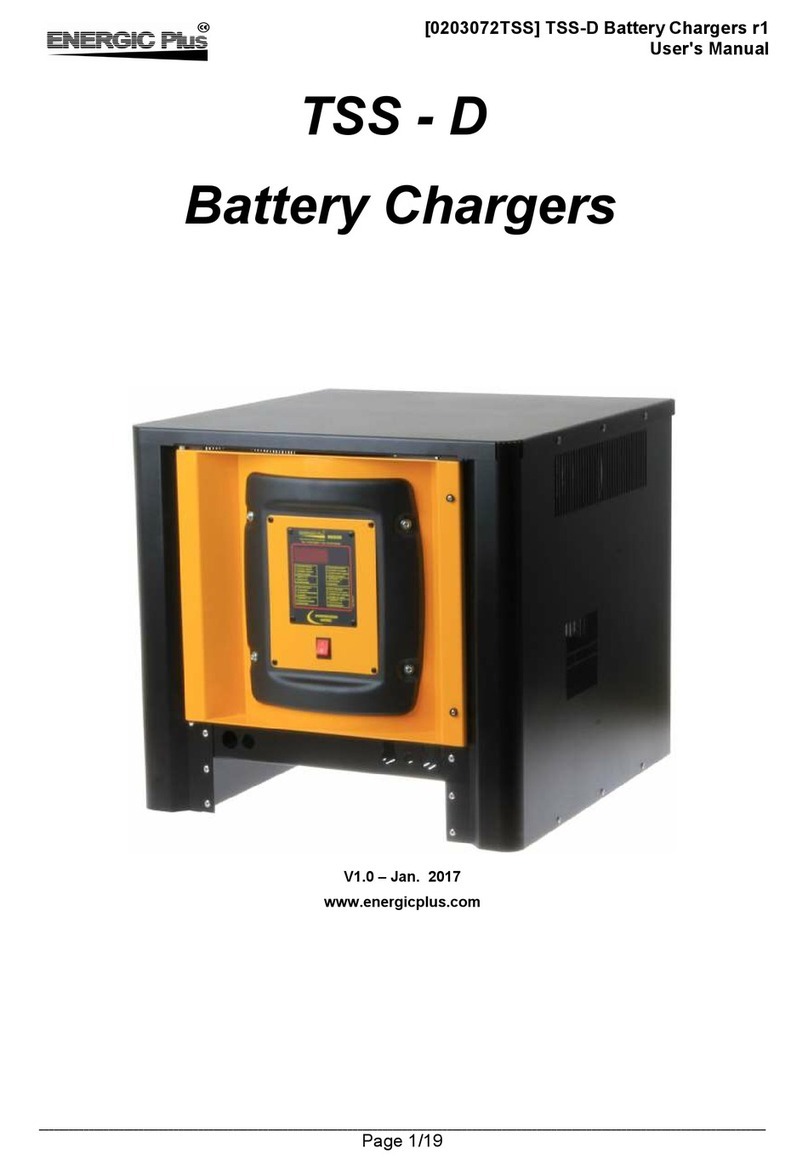
Energic Plus
Energic Plus TSS-D User manual
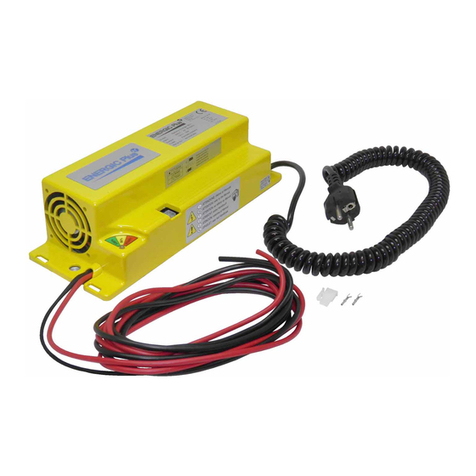
Energic Plus
Energic Plus BC1 User manual
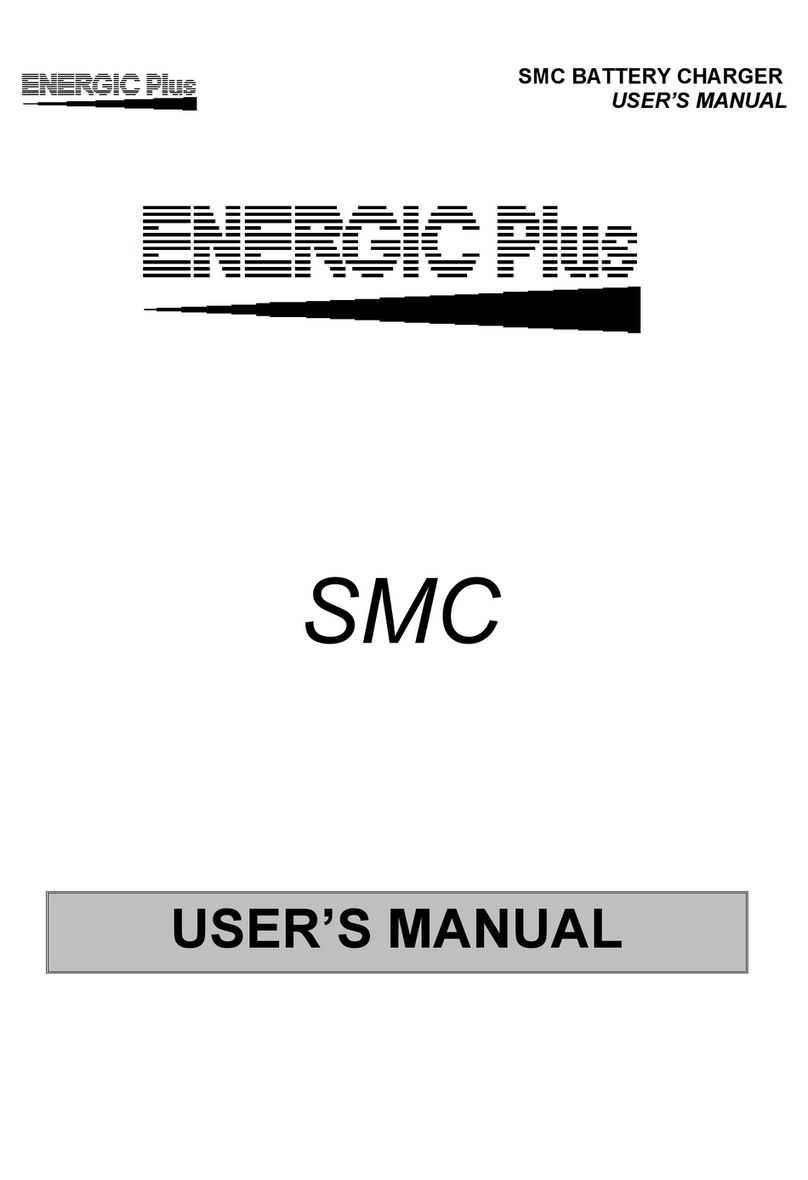
Energic Plus
Energic Plus SMC User manual
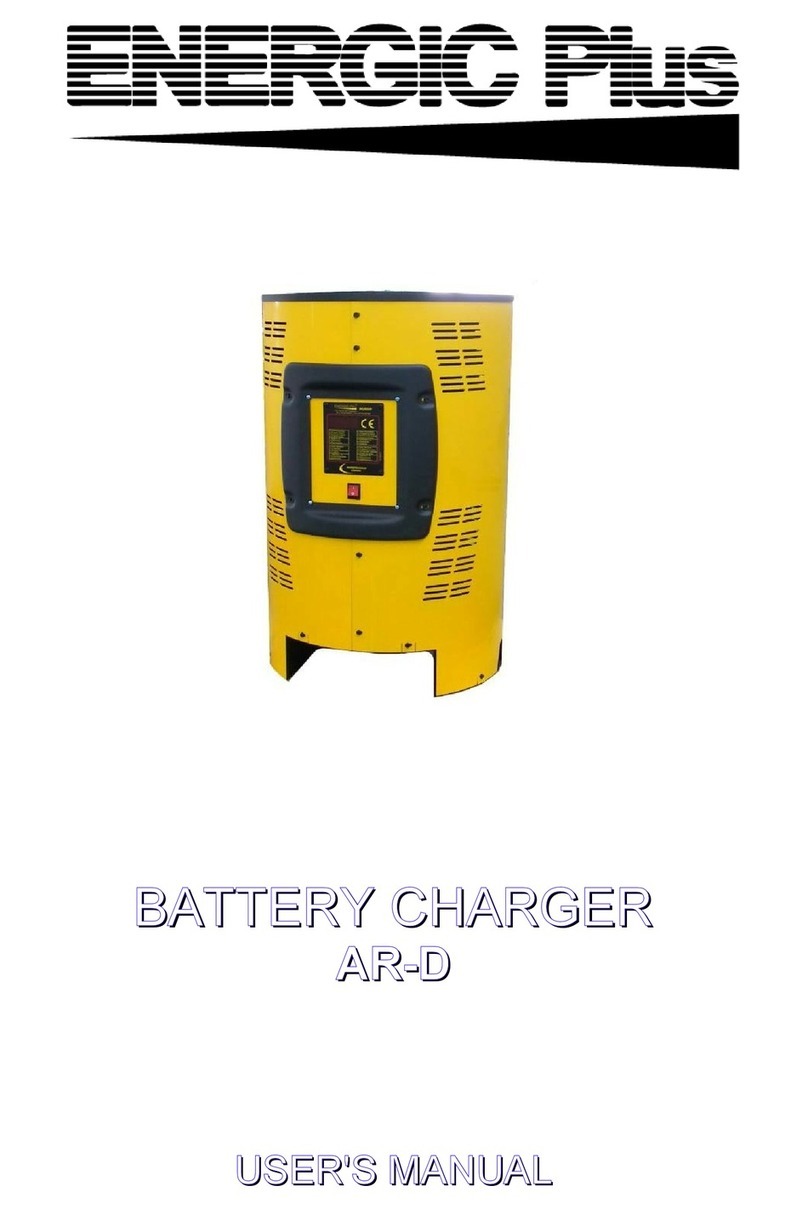
Energic Plus
Energic Plus AR-D User manual
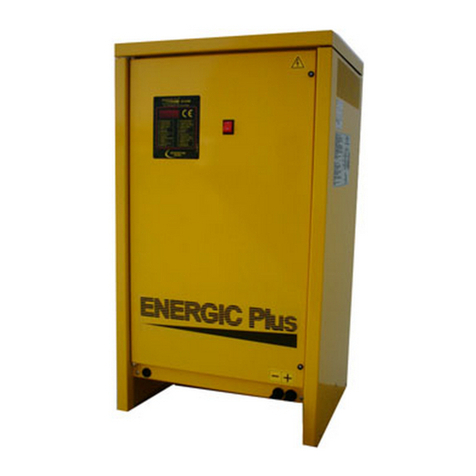
Energic Plus
Energic Plus TST-D User manual

Energic Plus
Energic Plus RX User manual
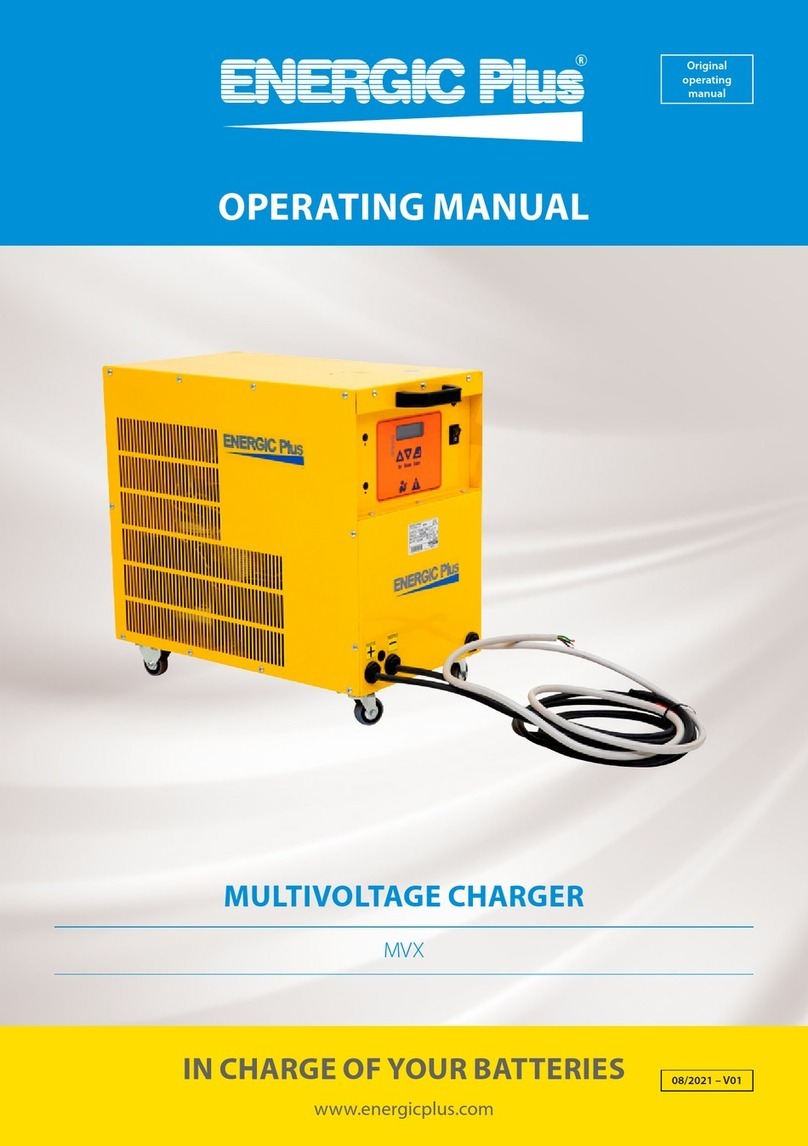
Energic Plus
Energic Plus MVX User manual

Energic Plus
Energic Plus 124TA1705 User manual

